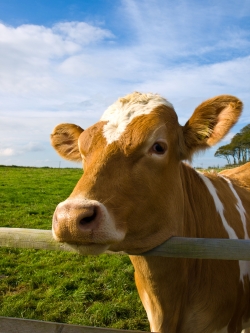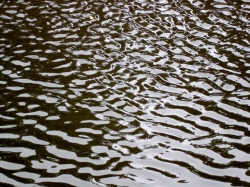AUGH! Shh. MOO! Tweet. HONK! Rustle. CRASH! Clink. The world is filled with sounds, both loud and quiet. They warn us of danger. They help us find each other. And, of course, they give us music to dance to. Have you ever really thought about what sound is? When a cow moos, does a part of the cow go around and fill everyone's ears? When a glass breaks, do little pieces of glass fly into our ears? Of course not. Not only would that really hurt, but you would run out of room in your ears very fast. Let's look at how sound changes the world for just a second before it goes away forever.

How now brown cow.
William Warby, CC BY 2.0 , via Wikimedia Commons
The planet is made of stuff. Stomp your foot against the ground, try to put your finger through your solid desk, breathe some air. It's all stuff.
Matter is anything that has mass or takes up space. Scientists use the word matter for anything that takes up space in the real world. This doesn't include thoughts you have or things people make up in their imaginations. Splash in water, bend a tree branch, or roll silly putty into a ball. That's all matter. Think of Harry Potter, pretend you're wearing a crown, tell your parents you saw an alien. None of that is matter. Now how does matter matter when it comes to sound?
Gather together ten people you know. (You do not have to do this. This is a test without matter.) You are all going to stand in a line, close together so all of your arms are touching. You will stand right at the end. Let's say your friends are all the parts that make up air. You, at one end, will be an ear. What happens when I go to the other end of the line and push that person? That person will fall into the next person, who will fall into the next, until it reaches you. You will kind of feel my push. After each person bumps the other, they will be able to stand up again. A
disturbance is when something changes for a very short amount of time. When sound moves through matter, which in this case is air, it disturbs it. All of its parts bump into each other so the sound can travel forward. Thanks for doing that experiment. Oh, your friends are mad at me for shoving them? Ahem. I had better go to the next paragraph before they make some bad sounds.
Of course, it cannot be as simple as that. If sound just needed to push air in order to move, then everything would sound the same. The cow would open its mouth and say AH. The car door would slam -- AH! The birds would flap through the air, ah ah ah ah ah ah. So to get the right sounds, we need something different. To
vibrate means to move back and forth very fast. It's like a very fast shaking. Think of a bee's wings. Think of a tight rubber band that you pluck. Think of a guitar string. I would ask your ten friends to come back to show how this can move through matter, but I think they are mad at me.
So sound shakes the air when it moves. This gives us all sorts of different sounds. The way sound moves air changes how things sound. To
oscillate means to move back and forth in a rhythm. If you swing on a swing at the same height each time, you are oscillating. Sound moves through the air as a wave moves through the water, looking nice and clean and smooth. Oscillations are a disturbance. But they are a pretty disturbance, even though they makes all the matter bump into each other. Here we can see how your friends bumping into each other made kind of a pretty wave. Maybe they will not be so mad at me now.

There's a ripple in my pond.
Ron Pieket, CC BY 3.0 , via Wikimedia Commons
Whether a whisper tickles your ear or a loud blast makes you clamp it shut, sound travels by making air bump into itself. If that's all sounds did, then it may just feel like a push to your ear, which would not be very nice. So sounds shake the air, making all sorts of noises that fill our world. MOO! HONK! Clink. Whisper. And everything in between. Tell your friends sorry from me for pushing them. To make them feel better, we will end with some soothing sounds. I just need you to think of some pretty violin music. It doesn't matter that it's not matter. Ah. There. Listen to how it vibrates the air.
References
Science Kids. "The Science of Sound for Kids" Science Kids, 2013. <
http://www.sciencekids.co.nz/sound.html>